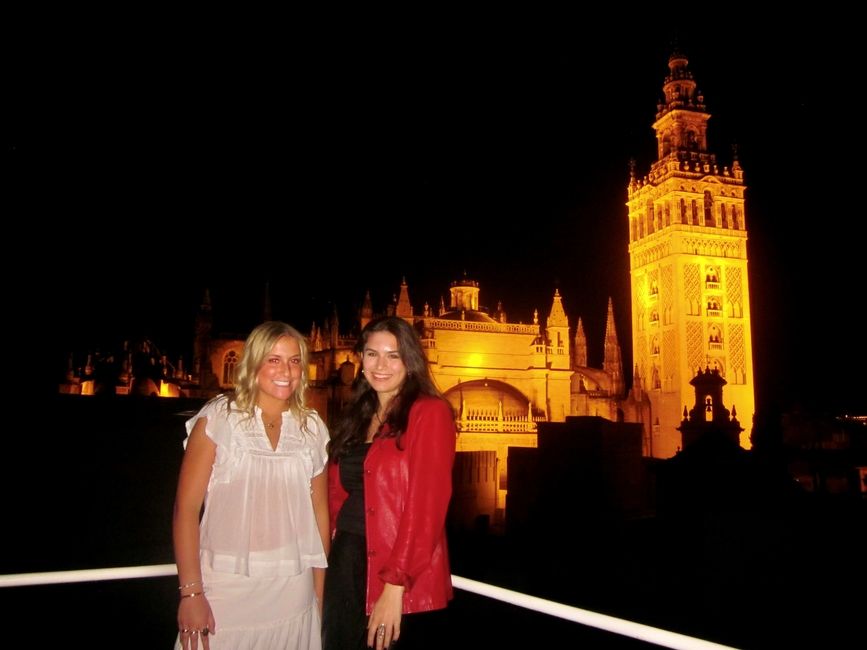How I Adjusted to Spanish Life During My Gap Year in Spain
Post written by CIEE Global Navigator alum Maxine G. who participated in the CIEE Gap Year Abroad program in 2023. In this post, Maxine shares her experience adjusting to life in Sevilla, Spain.
Buenas! My name is Maxine Gill, I recently turned 19 years old. This fall I will start my first year of college and I couldn't be more excited. However, a few months ago I returned from the most amazing Gap Year Abroad program with CIEE located in Sevilla, Spain and I can confidently say it was a positive life changing experience.
I’d like to share how I adjusted to the Spanish way of life while I was in Seville.
My Background
When I was a young girl, my mom always told me about her adventures traveling abroad, from her gap year in Ecuador to a summer in Chile. However, what piqued my interest the most were her stories about her semester abroad and summers in Spain.
So, when the time came last year, I decided that I wanted to take the gap year, and it had to be in Spain. I was very fortunate when I came across the Gap Year Abroad in Seville with CIEE.
Like many others, I had only heard of the major cities like Barcelona and Madrid, but I was unaware of the charming and historic city that would come to feel like a second home.
My First Few Days in Seville
Going in I was nervous like any other person moving to a new country for the first time. What if I can't speak the language well enough? Will I make friends? Are locals nice? Can I adjust to the cultural difference? I had so many questions and all of them were eventually answered.
Although it is different for everyone, I think I adapted a lot easier than I expected. Of course, I missed my family and friends, as well as the occasional pangs of hunger, like craving a Dr. Pepper or some good American-style pizza. However, shortly after I found that almost anything I wanted or ever needed was closer than I thought.
Adapting to Spanish
Like I said I found these cultural changes surprisingly easier to adjust to than expected but of course there were things that took time and things I truly could never adapt to. When I first arrived at my homestay one of the first cultural shocks I faced were greetings. My very kind and loving host mother Magdalena greeted me with a hug and two kisses on the cheek which I would later find out that in Spain it is common to greet with two kisses when you meet someone new. This would be a custom I would grow to love.
For me one of the most memorable differences is seeing restaurants filled everywhere all the time. It even kind of became a joke among friends because we would never see any restaurant empty. It was always so cool to see everyone lively outside during all hours of the day & night. Building on that as well it's very common when going out to dinner to eat outside. Usually, it depends on the weather but even in cold regions restaurants will provide accommodation so people can sit outside. In my experience I loved being able to almost always eat outside because it is very enjoyable, and you can soak in the sun with warm weather. It also would always be so interesting going out to a restaurant seeing all the outside tables filled then peering inside to see an almost empty restaurant. So, something to keep in mind is that the Spanish love eating outside!
Getting Used to Spanish Mealtimes & Siestas!
In the U.S. it's common to have a decent sized breakfast, a light lunch around 12 or 1 pm and dinner which is typically larger and is eaten anywhere from around 5 pm to 8 pm. I was shocked when I found out that the Spanish follow a very different schedule.
Although, where the U.S. and Spain find common ground is for breakfast which in Spain typically consists of coffee/tea with a pastry or bread and kids commonly eat cereal. This is quite similar to some American breakfasts minus the eggs, bacon, etc. In Spain they believe eggs are dinner food, but I'll get to that later!
Lunch is very different. A Spanish lunch is usually the biggest meal of the day and is eaten around 2 or 3 pm. The meal usually consists of courses and it's common for sobremesa to occur. You ask what sobremesa is? Well, sobremesa is the common Spanish act of relaxing and chatting with family and friends after the meal. The cool part is this can last anywhere from a few minutes to a few hours.
Sobremesa then leads into the known and loved Spanish siesta. In my experience siesta took place from 3-5pm during the weekdays and then when the weekends came there wasn't much need for siesta because the Spanish take their rest time seriously! I have to say though that the Spanish siesta is one of my favorite traditions because even if you don't use that time to nap everyday it's the perfect time to relax and take time for yourself, which I seldom find in the United States.
Moving on to dinner, Spaniards typically eat anywhere from 9 to 10:30pm, which as an American, seems very late, and for me is something I never completely adapted too. At the same time, I have to say that having this late dinner allows for a lot of free time in the afternoons to participate in sports, see friends, or get what you need to get done. Elaborating on, I would say their dinner is very light; think sandwiches, leftovers, etc. Also going back to my earlier remark about eggs, they are something you will find for dinner, maybe lunch, but never breakfast. As an American it hurts my heart a little, but if you go to American inspired breakfast spots you can find them there!
Not only do the times vary heavily but also the diets. The Spanish normally follow the mediterranean diet which is also commonly eaten in other mediterranean countries. This means lots of seafood, no red meat, lots of bread and olives, and always cooking in olive oil. I learned to like this way of eating, however not loving seafood sometimes made it difficult. I learned to love lots of foods from olives to gazpacho. Delving even deeper, we also have the tapas everyone knows and loves. Personally, some of my favorites are patatas bravas, huevos rotos, and so many more. I can say without doubt I gladly welcomed them into my life. Overall, I would say I still see some of the influences of the Spanish ways in my diet now being in the United States.
Embracing Cultural Differences While on Your Gap Year
Traveling to Spain I knew I would face cultural differences, but most times they were differences that made me grow and take an interest in a culture different than my own. Sometimes I would even laugh about our differences together with my host family.
I'm very grateful to have taken a gap year with CIEE that gave me so many incredible opportunities, friends, knowledge and helped me to widen my worldview.
I hope by hearing about some of my experiences as an American who has lived in Spain, I can help you in any way! Hopefully it inspires you to take the leap and follow your travel dreams.
Related Posts
Wrapping Up My Gap Year Abroad in Spain
Post written by CIEE Global Ambassador Lindsey Andel who is currently participating in CIEE’s Gap Year Abroad Program in Spain . In this post, Lindsey reflects on her transformative experience... keep reading
7 Tips for Learning Spanish While on a Gap Year Abroad
The Spanish immersion participant experience while on a CIEE Gap Year Abroad is the absolute best way to learn the language. While abroad, you'll hear, read and speak Spanish everywhere... keep reading
My Daily Routine in Spain as a Gap Year Abroad Student
Post written by CIEE Global Ambassador Lindsey Andel who is currently participating in CIEE’s Gap Year Abroad Program in Spain . In this post, Lindsey shares about her daily life... keep reading








